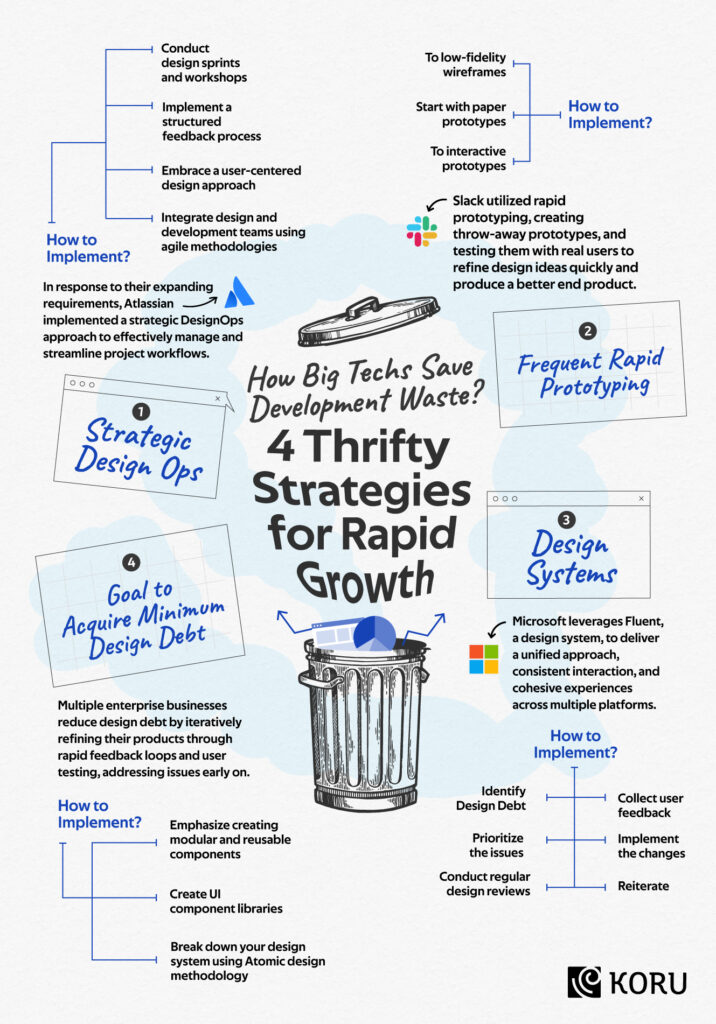In 2001, two Americans started a side project to explore the scope of email marketing at scale. This business was bootstrapped from day one and continued to be till they were acquired for a whopping $12 billion by Intuit in the year 2021. In the two decades, this so-called side-project turned into a unicorn for silicon valley. The business in question? Mailchimp.
Now what did Ben Chestnut and Dan Kurzius do with Mailchimp that other businesses couldn’t do well? They maintained a laser-sharp focus on ease of use and every new idea and feature was seen with the same lens.
That is what separates successful product companies from others. They adopt practices that enable them to become masters of efficient product development, consistently delivering innovative solutions while minimizing waste. Their success lies in adopting strategic approaches and implementing effective techniques that optimize resources and accelerate growth.
Through this article, we are sharing some of the key strategies used by the largest tech companies around the world to turbocharge their product development and cut waste with design-led strategies.
Strategic Design Ops: Streamlining Project Workflows
Optimizing project workflows is quite similar to solving mysteries. One needs to evaluate the motivation and behavior from every angle possible, connect the dots, and figure out what are the different ways to do something like this (and then go ahead with the easiest one). Take Atlassian for example. Their tools have been built to cater to multiple users working on the same tool across the world. To ensure easy adoption and coherence, they have implemented strategic DesignOps approaches to effectively manage and streamline project workflows. By embracing a user-centered design approach and integrating design and development teams using agile methodologies, they create a seamless collaboration process.
Here’s how you can implement this strategy:
- Conduct design sprints and workshops to foster creativity and ideation.
- Implement a structured feedback process to ensure continuous improvement.
- Embrace user-centered design by conducting user research and incorporating user feedback into the design process.
- Create a loop of feedback, research, analysis, and design to iteratively refine and optimize the product.
Frequent Rapid Prototyping: Refining Design Ideas Quickly
Product teams often undermine the value of a simple sketch or a rough prototype, and the ones who don’t see immense value in trying out new ideas, getting the user reaction on it, and fine-tuning or discarding it without investing too much time and budget into it.
Big Tech companies such as Slack rely on frequent rapid prototyping to iterate and refine design ideas rapidly. By creating throw-away prototypes and testing them with real users, they gather valuable insights and produce better-end products. Google’s famous paper prototypes have been common amongst the design community as a beautiful reminder of how simple things can create significant value.
You can do the same for your product team with this simple approach:
- Start with paper prototypes to quickly visualize design concepts and gather initial feedback.
- Progress to low-fidelity wireframes to refine the layout and interactions.
- Develop interactive prototypes to simulate the user experience and test usability.
- Iterate based on user feedback and continuously refine the design.
Design Systems: Ensuring Consistency and Cohesion
Imagine if enterprise applications were like the games of Spot the Difference. But instead of random scenery, it is a screen designed by different designers working on slightly different briefs with completely versatile personas in their minds. The result? A tool that looks like it was half-baked and put on the shelves. Lack of consistency and cohesion also poses large risks of errors such as Avon’s failed ERP implementation and Citygroup’s $500 million mistake.
The solution to such costly mistakes? An integrated design system from the get-go! Microsoft leverages design systems, like Fluent, to deliver a unified approach, consistent interaction, and cohesive experiences across multiple platforms. By breaking down their design system using the Atomic design methodology and creating UI component libraries, they establish a foundation for scalable and efficient design.
Here’s how you can implement this strategy:
- Break down your design system using the Atomic design methodology, which involves designing in terms of atoms (basic elements) and combining them into molecules (components) and organisms (interface structures).
- Create UI component libraries to standardize and reuse design elements.
- Emphasize creating modular and reusable components to ensure consistency and efficiency throughout the design process.
Goal to Acquire Minimum Design Debt: Iterative Refinement
Engineering teams are focused on tech debt but product teams are not as focused on design debt. Debt is (obviously) bad. But design debt is the worst because it often leads to no other option but a complete design overhaul that can be time-consuming and expensive. To avoid this, having a system in place to manage and monitor the design backlogs, and clear them based on priority is an effective way to counter them.
Large tech companies prioritize addressing design debt by iteratively refining their products through rapid feedback loops and user testing. By conducting regular design reviews, identifying design debt, and prioritizing issues, they ensure continuous improvement. Here’s how you can implement this strategy:
- Conduct regular design reviews to identify areas for improvement and address design debt proactively.
- Identify design debt by analyzing user feedback, usability testing results, and metrics.
- Prioritize the identified issues based on their impact and feasibility of implementation.
- Implement the necessary changes and collect user feedback to validate improvements.
- Continuously iterate and refine the design to minimize design debt and deliver a superior user experience.
Remember, by streamlining project workflows, refining design ideas quickly, ensuring consistency and cohesion, and continuously refining your product, you can propel your organization toward rapid growth and success in the digital age. If you like this article or the infographic, feel free to share it with your network and embed it in your articles.










